The NVIDIA GeForce RTX 2060 6GB Founders Edition Review: Not Quite Mainstream
by Nate Oh on January 7, 2019 9:00 AM ESTWolfenstein II: The New Colossus (Vulkan)
id Software is popularly known for a few games involving shooting stuff until it dies, just with different 'stuff' for each one: Nazis, demons, or other players while scorning the laws of physics. Wolfenstein II is the latest of the first, the sequel of a modern reboot series developed by MachineGames and built on id Tech 6. While the tone is significantly less pulpy nowadays, the game is still a frenetic FPS at heart, succeeding DOOM as a modern Vulkan flagship title and arriving as a pure Vullkan implementation rather than the originally OpenGL DOOM.
Featuring a Nazi-occupied America of 1961, Wolfenstein II is lushly designed yet not oppressively intensive on the hardware, something that goes well with its pace of action that emerge suddenly from a level design flush with alternate historical details.
The highest quality preset, "Mein leben!", was used. Wolfenstein II also features Vega-centric GPU Culling and Rapid Packed Math, as well as Radeon-centric Deferred Rendering; in accordance with the preset, neither GPU Culling nor Deferred Rendering was enabled. NVIDIA Adaptive Shading was not enabled.
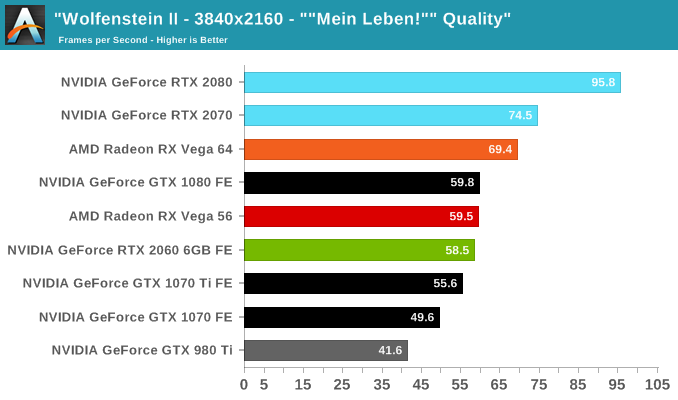


In summary, Wolfenstein II tends to scales well, enables high framerates with minimal CPU bottleneck, enjoys running on modern GPU architectures, and consumes VRAM like nothing else. For the Turing-based RTX 2060 (6GB), this results in outpacing the GTX 1080 as well as RX Vega 56 at 1080p/1440p. The 4K results can be deceiving; looking closer at 99th percentile framerates shows a much steeper dropoff, more likely than not to be related to the limitations of the 6GB framebuffer. We've already seen the GTX 980 and 970 struggle at even 1080p, chained by 4GB video memory.
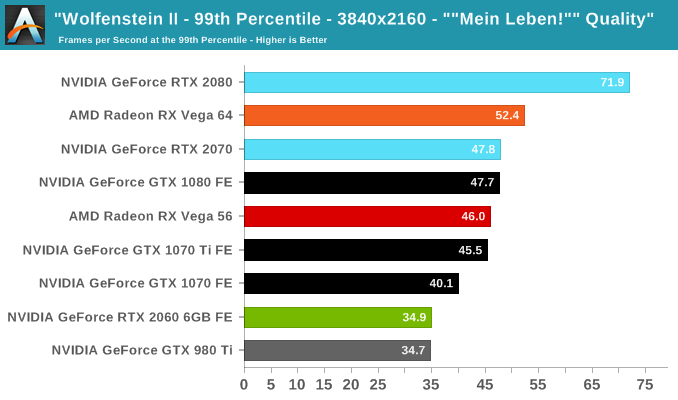
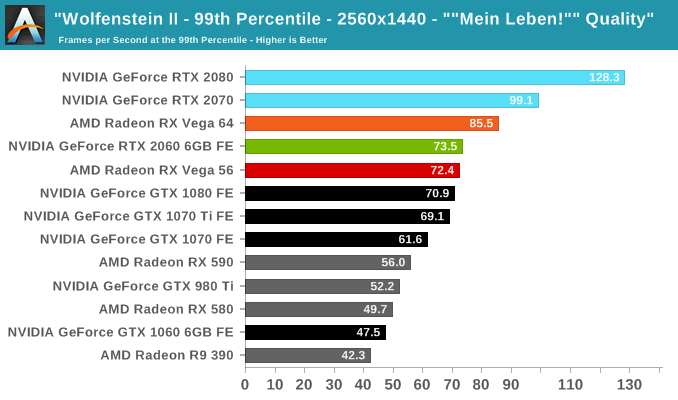
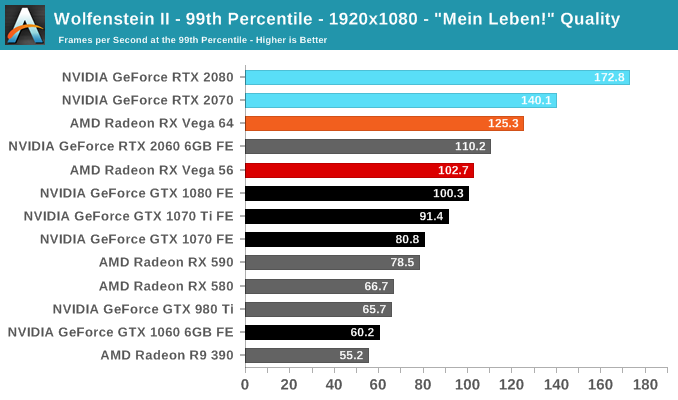


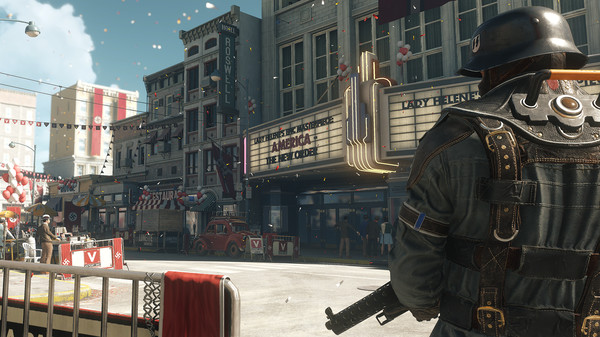








134 Comments
View All Comments
just4U - Wednesday, January 23, 2019 - link
wait late to this and likely no one will read it but shoot you never know. I have Vega cards. I undervolt and overclock. They work great.sing_electric - Monday, January 7, 2019 - link
Here's the thing, though, right now, there ISN'T a card on the market that offers anything like that level of performance for that price, if you can actually buy one for close to MSRP. The RX 590 is almost embarrassing in this test; a recently-launched card (though based on older tech) for $60 less than the 2060 but offering nowhere near the performance. The way I read the chart on performance/prices, there's good value at ~$200 (for a 580 card), then no good values up till you get to the $350 2060 (assuming it's available for close to MSRP). If AMD can offer the Vega 56 for say, $300 or less, it becomes a good value, but today, the best price I can find on one is $370, and that's just not worth it.jrs77 - Monday, January 7, 2019 - link
I don't say, that the 2060 isn't good value, but it simply is priced way too high to be a midrange card, which the xx60-series is supposed to be.Midrange = $1000 gaming-rig and that only leaves some $200-250 for the GPU. And as I wrote, even the 1060 was out of that pricerange for most of the last two years.
sing_electric - Monday, January 7, 2019 - link
I totally get your point - but to some extent, it's semantics. I'd never drop the ~$700 that it costs to get a 2080 today, but given that that card exists and is sold to consumers as a gaming card, it is now the benchmark for "high end." The RTX 2060 is half that price, so I guess is "mid range," even if $350 is more than I'd spend on a GPU.We've seen the same thing with phones - $700 used to be 'premium' but now the premium is more like $1k.
The one upside of all this is that the prices mean that there's likely to be a lot of cards like the 1060/1070/RX 580 in gaming rigs for the next few years, and so game developers will likely bear that in mind when developing titles. (On the other hand, I'm hoping maybe AMD or Intel will release something that hits a much better $/perf ratio in the next 2 years, finally putting pricing pressure on Nvidia at the mid/high end which just doesn't exist at the moment.)
Bluescreendeath - Monday, January 7, 2019 - link
It could be possible that the GTX2060 is not midranged but lower high range card. Most XX60 cards in the past were midranged, but they were not all midranged. Though most past XX60 cards have been midranged and cost around $200-$300, if you go to the GTX200 series, the GTX260's MSRP was $400 and was more of an upper ranged card. The Founder's Edition of the 1060 also launched at $300.dave_the_nerd - Monday, January 7, 2019 - link
Weeeeeeeeeelllll.... before all the mining happened, the 970 was a pretty popular card at $300-$325. (At one point iirc it was the single most popular discrete GPU on Steam's hardware survey.)Vayra - Wednesday, January 9, 2019 - link
Yeah, I think 350 is just about the maximum Nvidia can charge for midrange. The 970 had the bonus of offering 780ti levels of performance very shortly after that card launched. Today, we're looking at almost 3 years for such a jump (1080 > 2060).StrangerGuy - Wednesday, January 9, 2019 - link
I paid an inflated $450 for my launch 1070 2.5 years, and this 2060 is barely faster at $100 less. Godawful value proposition especially when release dates are taken into consideration.ScottSoapbox - Monday, January 7, 2019 - link
I wonder if custom 2060 cards will add 2GB more VRAM and how much that addition will cost.A5 - Monday, January 7, 2019 - link
It's been a *long* time since I've seen a board vendor offer a board with more VRAM than spec'd by the GPU maker. I would be surprised if anyone did it...easier to point people at the 2070.